Firefall Yosemite: A Beginners Guide to Seeing it
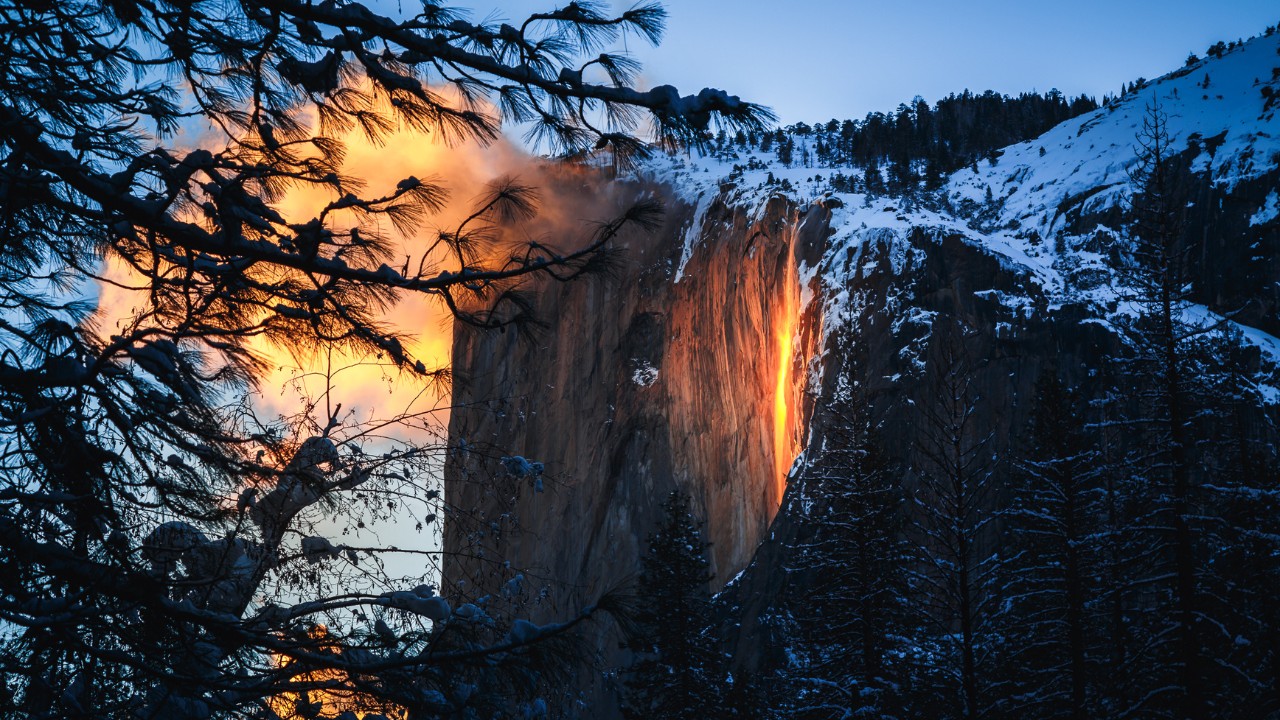
You’ve probably seen stunning photos of the Firefall event in Yosemite and wondered if it’s real. The answer is that it is most defintely a real thing that occurs in the park, but timing and luck are what you need in order to catch it and this article is going to provide you with all the info you need to improve the odds that you see this amazing event.
Overview:
The Yosemite Firefall is a natural spectacle that happens at Horsetail Falls, a seasonal waterfall that flows over the eastern edge of El Capitan. For a few days each year, the setting sun aligns perfectly with the waterfall, illuminating it in fiery orange and red hues. When conditions are right, the waterfall appears to be glowing as if it’s made of molten lava.
The Firefall should not be confused with the original man-made Firefall at Glacier Point, where burning embers were pushed over the cliff edge, creating a similar visual effect. The Glacier Point Firefall was discontinued in 1968, but the natural Firefall at Horsetail Fall has become a popular phenomenon in recent decades.
Photos:
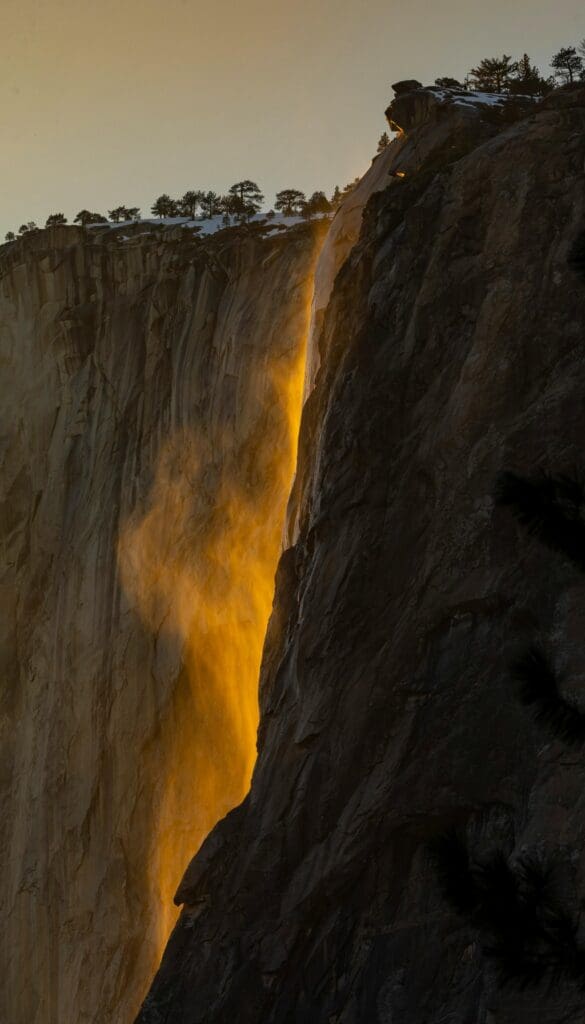
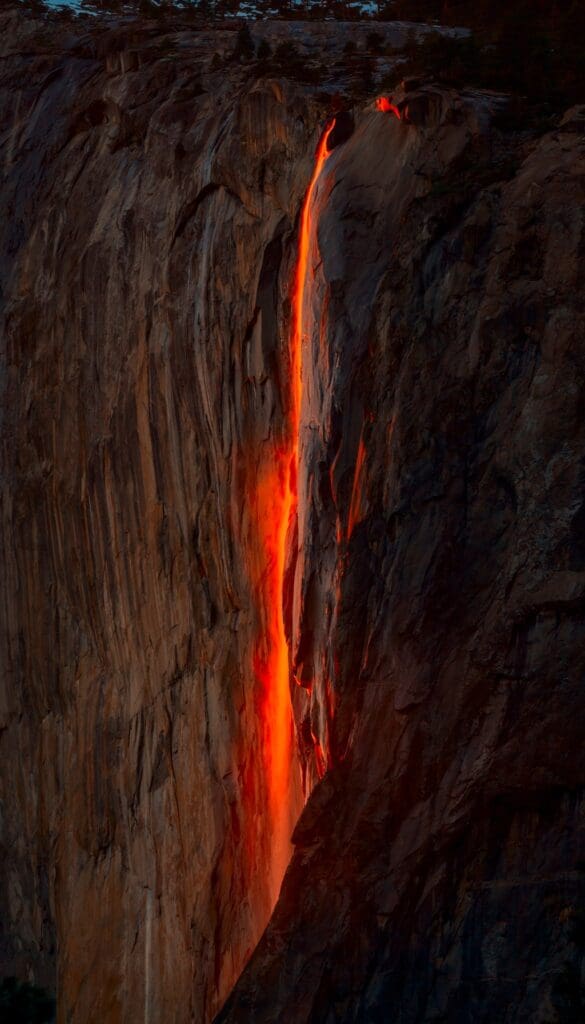
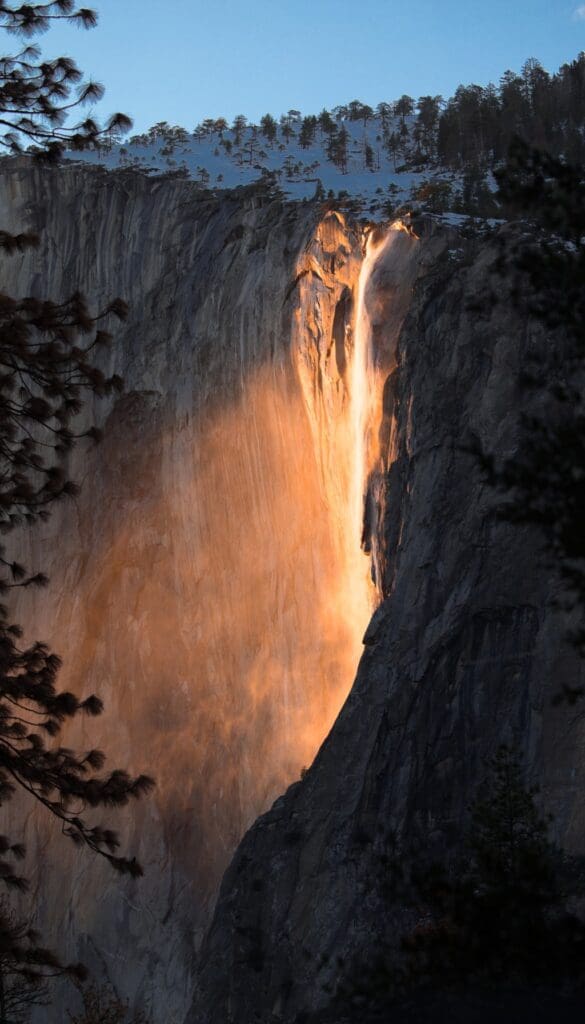
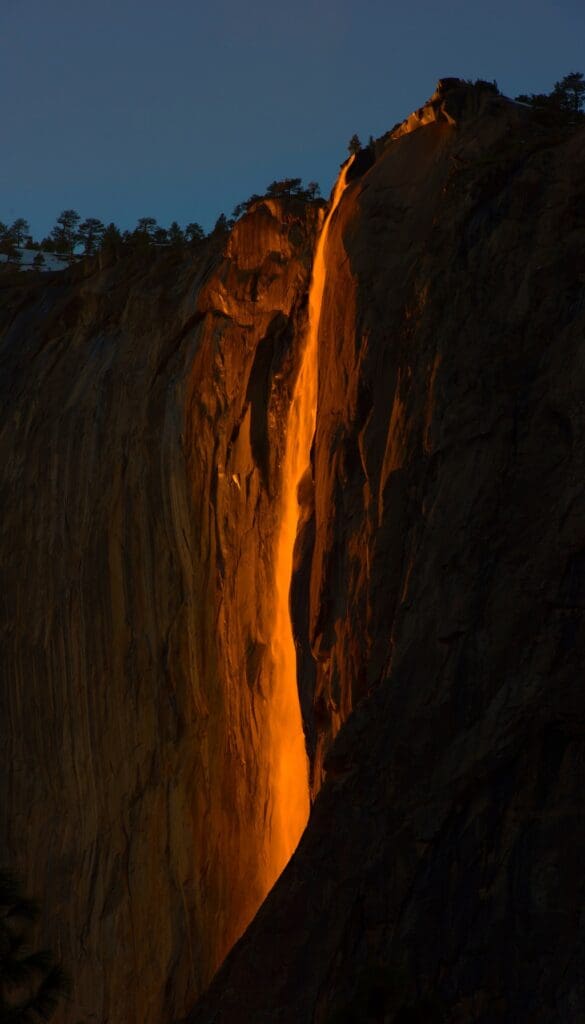
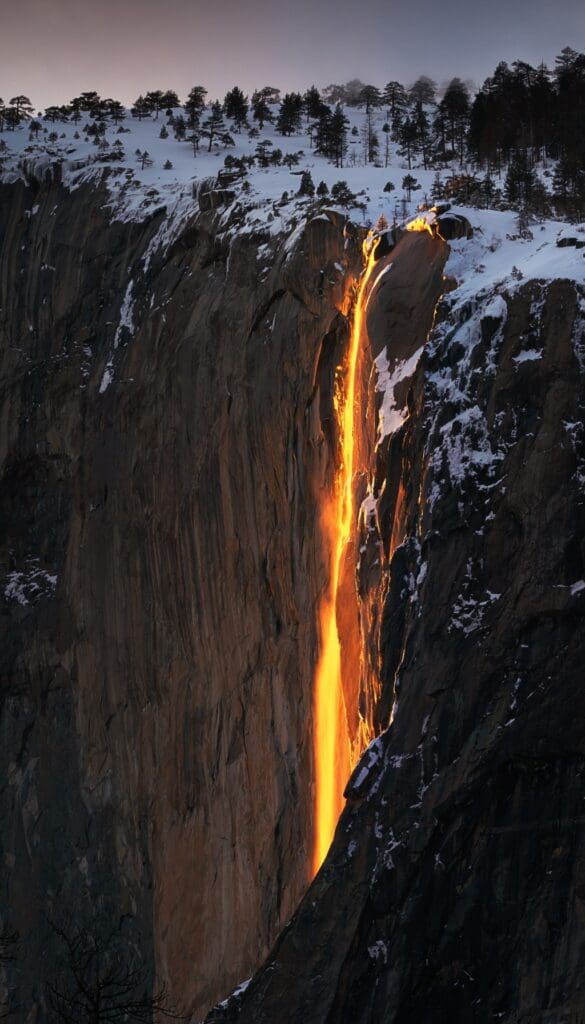
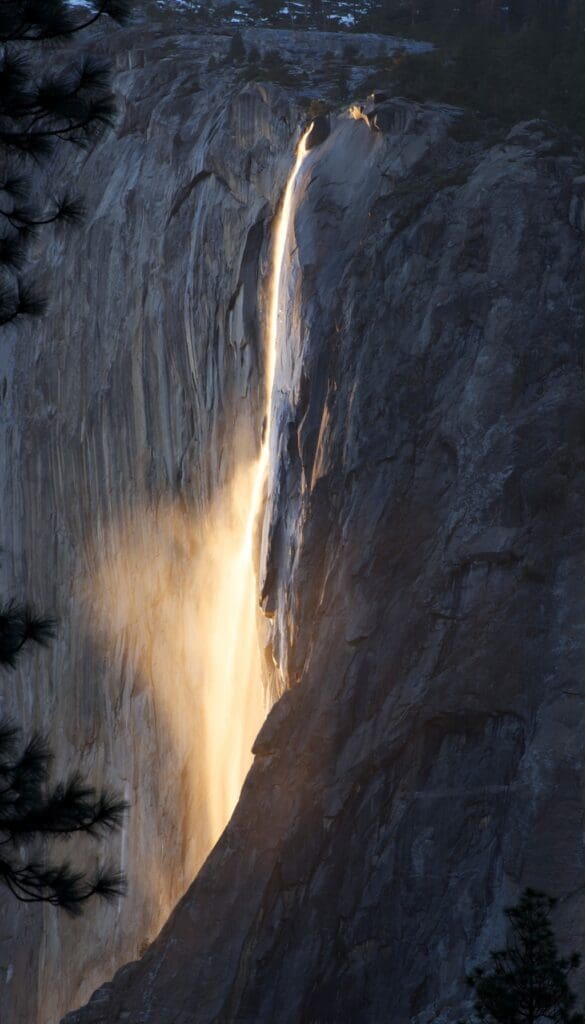
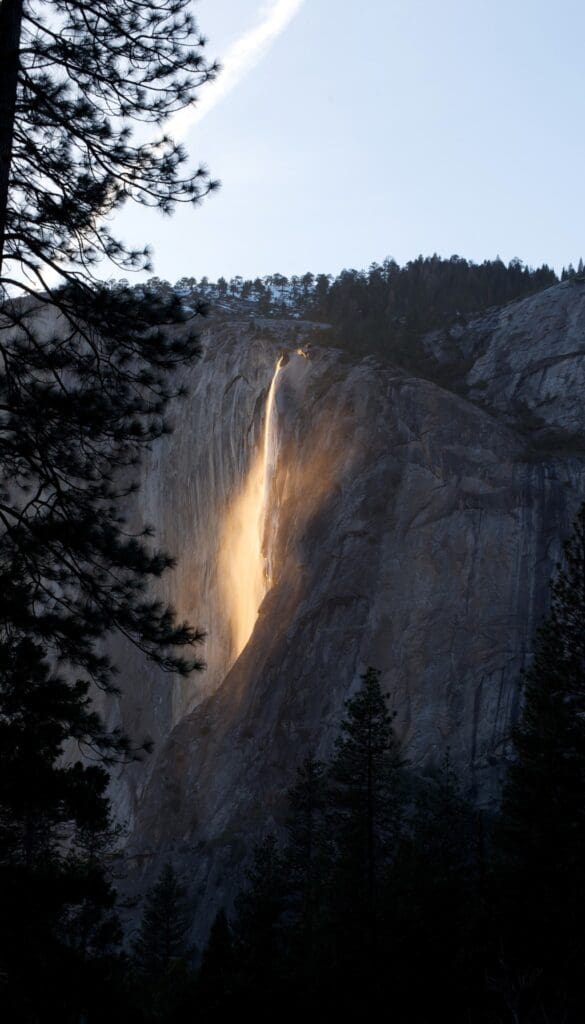
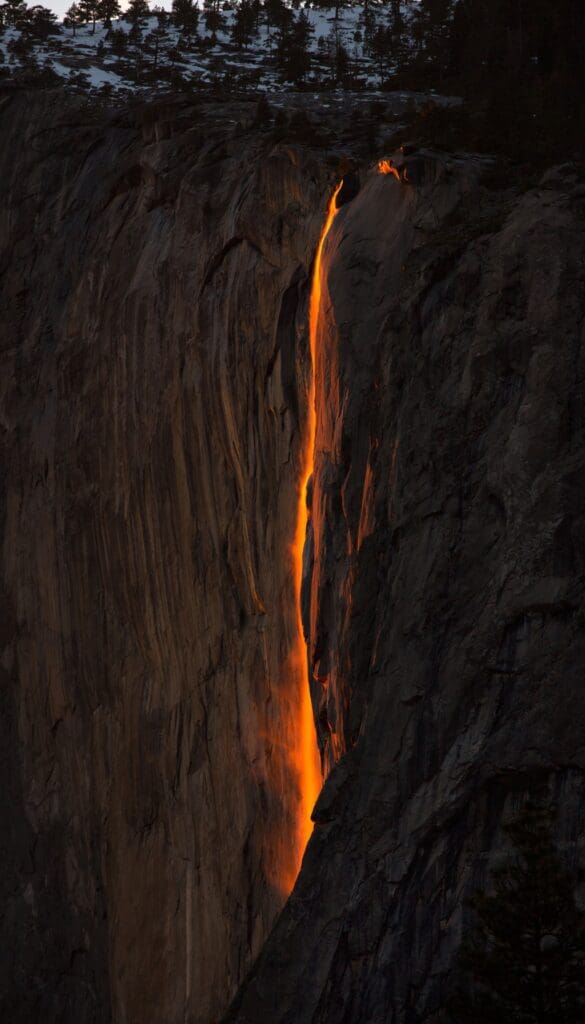
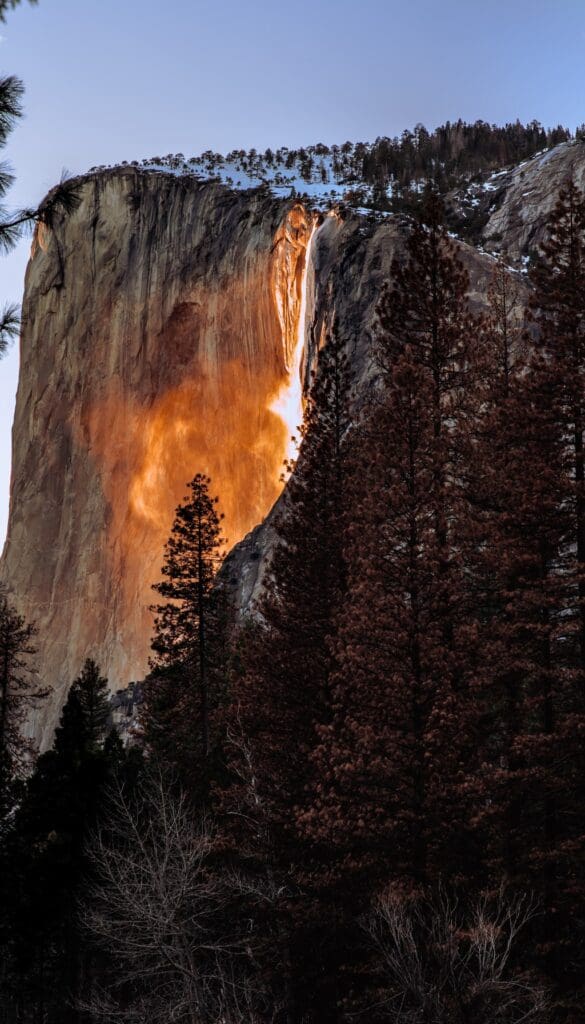
When to see it:
The Firefall typically occurs in mid-to-late February, with the best viewing window between February 10 and February 28. However, the spectacle is highly dependent on several natural factors:
- Sunset Alignment: The sun must be at the right angle to illuminate Horsetail Falls, which only happens in February.
- Clear Skies: Clouds, fog, or haze can obstruct the sunlight, diminishing or completely preventing the fiery effect.
- Water Flow: Horsetail Fall relies on snowmelt from the Sierra Nevada. Warm days or rainfall during February can help increase the flow, while colder or drier weather can reduce it. If there’s insufficient water, the Firefall effect won’t be visible.
Best Viewpoints to See it:
There are a few key locations in Yosemite Valley (lowest elevation in the park where most visitors go) that offer optimal views of the Firefall.
- El Capitan Picnic Area: This is the most popular viewing location, situated along Northside Drive. It provides a direct line of sight to Horsetail Fall and is the closest viewing spot, making it ideal for photography.
- Southside Drive: Located across the Merced River from El Capitan Picnic Area, Southside Drive offers a broader perspective of Horsetail Fall. Photographers can capture the reflection of the Firefall in the river if water levels and lighting conditions are right.
- Cook’s Meadow: While not as close as the other spots, Cook’s Meadow provides a wide-angle view of Yosemite Valley, with the Firefall and the surrounding cliffs creating a dramatic scene.
- Cathedral Beach Picnic Area: This area offers a more distant view but can be less crowded. It’s a good option for visitors seeking a quieter spot away from the main crowds.
- Note: There are new rules for viewing the Firefall event. Many visitors will need to park further away from the above points and walk over 1 mile each way to get to the viewing areas. This is why it is very important to bring warm clothing and other proper gear.
Tips For Viewing:
- Arrive Early: The Firefall is extremely popular, attracting hundreds of visitors each evening during the viewing window. Parking is limited, so plan to arrive by mid-afternoon to secure a spot, especially on weekends and holidays.
- Be Prepared for Cold Weather: February in Yosemite can be cold, with temperatures often dropping below freezing in the evening. Dress in layers, wear a warm hat, gloves, and bring a blanket if you plan to sit and wait for the show.
- Bring a Headlamp or Flashlight: Since the Firefall occurs at sunset, you’ll be leaving the viewing area in the dark. A headlamp or flashlight will help you navigate safely back to your car or shuttle.
- Pack Snacks and Water: There are no food vendors at the viewing locations, so bring snacks and water to stay energized while you wait for the Firefall.
- Stay Updated on Conditions: The Yosemite Firefall is a weather-dependent event. Check the Yosemite National Park website or local weather forecasts for updates on snowmelt, water flow, and sunset times to ensure that conditions are favorable. There are times where parts of the park’s roads may be closed due to icy roads.
Photography tips:
The Firefall is a dream subject for photographers and though a good smartphone camera can capture beautiful imagery, the best ones you see online are typically done by professional cameras. Here are some tips for adjusting your camera to improve the settings to get the best photo:
- Use a Telephoto Lens: A telephoto lens (200mm or longer) will help you capture close-up shots of Horsetail Fall, bringing out the details of the fiery effect.
- Use a Tripod: The low light conditions at sunset require longer exposure times, so a tripod is essential to keep your camera steady and avoid blurry shots.
- Adjust Exposure Settings: Start with an aperture of f/8 to f/11 for optimal depth of field. Use a low ISO (100-200) to reduce noise, and adjust your shutter speed based on the changing light. Bracketing your shots—taking multiple exposures at different settings—can help you capture the best possible image.
- Shoot in RAW Format: Shooting in RAW allows for more flexibility in post-processing, helping you bring out the vibrant colors of the Firefall.
- Arrive Early for Positioning: To get the best composition, arrive at your chosen location at least 2-3 hours before sunset. This will give you enough time to set up your equipment, frame your shots, and adjust for changing light conditions.
- Be Patient: The Firefall’s intensity can vary from minute to minute, so be patient and continue shooting as the light changes. The best glow often occurs just before the sun fully sets.
Recommended cameras:
- Body cameras: Nikon D850 or a Sony A7 III
- Lens: NIKKON Nikkor Z 20MM or a Sigma 150-600MM
- Tripod: NEEWER Carbon Tripod
Other Things to Do:
If you’re spending the day (or several) in Yosemite before the Firefall viewing, here are some other activities and attractions to consider:
- Yosemite Falls: Located nearby, Yosemite Falls is one of the tallest waterfalls in North America. A short hike to the base offers a closer look, with mist and roaring water adding to the experience.
- Valley Loop Trail: This moderate trail circles the Yosemite Valley floor, offering iconic views of El Capitan, Bridalveil Fall, and Half Dome. It’s a great way to explore the valley while waiting for sunset.
- Yosemite Village: Stop by the Yosemite Visitor Center, Ansel Adams Gallery, or Yosemite Museum to learn more about the park’s history, geology, and cultural heritage.
- Tunnel View: For one of the most famous views of Yosemite, visit Tunnel View, which provides a breathtaking panoramic vista of El Capitan, Bridalveil Fall, and Half Dome. More things to do.
Essential Tips for a Successful Visit:
- Plan for Accommodation: Given the popularity of the Firefall event, consider booking accommodations well in advance. Options include lodges, cabins, and campgrounds within the park, as well as hotels in nearby towns like El Portal or Oakhurst. See top hotels near Yosemite.
- Use the Park Shuttle: During peak viewing days, parking can be challenging. Consider using the Yosemite Valley Shuttle, which offers convenient stops throughout the park, including popular Firefall viewing areas.
Last Things to Know:
Even with all the right conditions, the Firefall can be unpredictable. Clouds, haze, or insufficient water flow can affect the display, so try to stay flexible and allow for multiple days in your itinerary to increase your chances of seeing the Firefall at its best. The Yosemite Firefall is a captivating natural phenomenon that offers a truly magical experience for visitors lucky enough to witness it.
With the right planning, preparation, and a little bit of luck, you can enjoy one of nature’s most spectacular shows at Horsetail Fall. Whether you’re a seasoned photographer or simply looking to marvel at the fiery display, the Yosemite Firefall is a bucket-list event that should not be missed.
